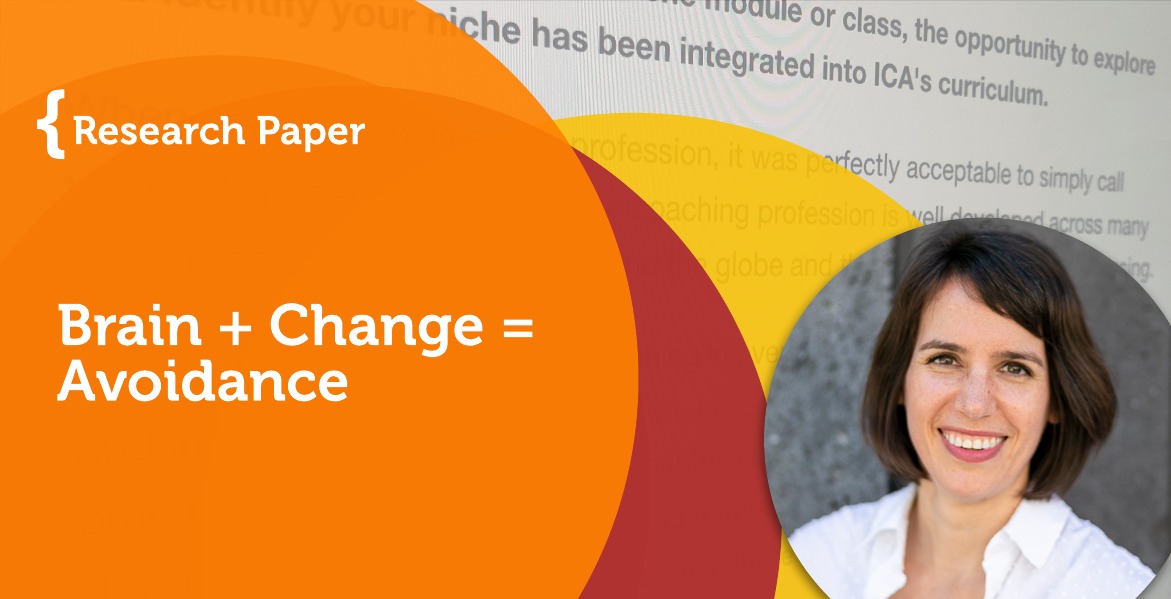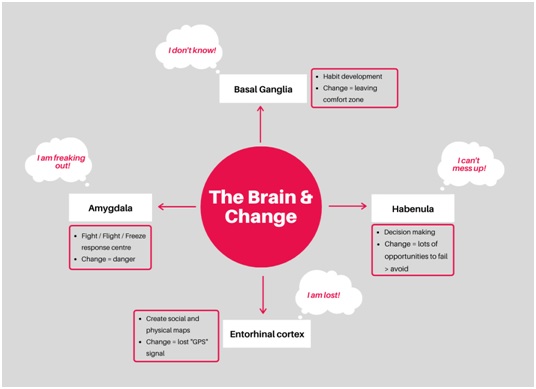 Research Paper By Simone Anzboeck
Research Paper By Simone Anzboeck
(Impact Coach for conscious business and leaders, MYANMAR)
How brain-based coaching can support clients adapting to change
Introduction
This paper is written for clients and coaches alike. It is written for those interested in learning more about what latest science tells us about how our brain reacts to change. Also, the paper will address what we can do about it and why having a coach can be the best support.
What is the change?
In the ongoing flux of life, (the person) undergoes many changes. Arriving, departing, growing, declining, achieving, failing – every change involves a loss and again. The old environment must be given up, the new accepted. People come and go; one job is lost, another begun; territory and possessions are acquired or sold; new skills are learnt, old abandoned; expectations are fulfilled or hopes dashed – in all these situations the individual is faced with the need to give up one mode of life and accept another.[1]
However, change from the brain perspective occurs in some of the most mundane things. Have you ever brushed your teeth with your other hand? Go ahead and try it.
How does our brain affect decision making and adapting to change?
It is essential to understand some crucial brain functions and how they become active when we are faced with a change of any form. According to Britt Addreatta[2], four brain structures are incredibly essential to understand with regards to our response to change.
Figure 1 has been developed based on information from Addreatta’s book Wired to Resist[3], which outlines critical brain areas and their response to changes.
 Figure 1: Selection of brain functions vital to understand when looking at change; adopted from Wired to Resist (Andreatta, 2017)
Figure 1: Selection of brain functions vital to understand when looking at change; adopted from Wired to Resist (Andreatta, 2017)
Fourcrucialareas involved in assessing a situation of change are:
Our brain continually sorts our experiences and surroundings and filters them through these (and other) brain functions. Can you see how easy it is for our brain to respond in an avoidant way due to our wiring and its need to protect us humans (from change)?
But what does that mean for you?
Imagine you start a new job. Your social and physical maps need to be updated. Your entorhinal cortex initiates you feeling lost as your brain develops new maps of your new surroundings and relationships. At the same time, your habenula is detecting lots of opportunities to fail. You get anxious.
You want to lose weight. But because your daily habits, including when and what you eat, have become routine and so you are not aware enough to break that cycle – your basal ganglia is in the way.
You move to a new country. Your amygdala is afraid of what the change brings. Your entorhinal cortex is lost as all your social and physical maps need updating.
You want to start a business, but your habenula screams loud that there are too many opportunities to fail, so you doubt yourself.
What can we do about it?
The beautiful thing is that there is agreement among neuroscientists that the brain can change, it is highly plastic. Over the last years, neuroplasticity has revealed a lot about how our brain functions. Neuroplasticity is a sub-section of neuroscience involved with how the brain changes. The neurons in our brain can form new connections, one can establish new habits, routines, behaviours et al. by using how the brain works to the advantage. Our brain physiologically changes and adapts to new stimuli all the time – whether because of external stimuli or stimuli we give the brain. An image to use is to think of the brain as “a dynamic, connected power grid where pathways light up every time you think, feel or do something”[4].
Have you tried brushing your teeth with your non-dominant hand yet? Brushing your teeth with your dominant hand is a well-worn pathway in your brain; it has become effortless and automatic for our brain to do this. The same applies to our thoughts, feelings, and emotions. But if you want to brush your teeth with your non-dominant hand, it is hard at first. Only by using consistent and repetitive effort, that new pathway becomes effortless again. Eventually, you have re-weird your brain to a new dominant hand to brush your teeth with.
The reason that this is possible is that we can “outthink our circumstances”[5]. If one can become aware of their thinking, feelings, habits, and current behaviours, and choose new thought, feeling and behaviour often enough, the brain will change. Once you do that long enough, the brain will have formed new neural pathways. What was the ‘new normal has become the new comfort zone[6].
How can one do that? To effectively change the brain, one needs to[7]:
- Assess the bad habits, thoughts, feelings that one wants to change;
- Choose a new habit, thought and feeling and reinforce the new behaviour by thinking forward; visualising it; doing it and experiencing it.
Jeffrey Schwartz coined the term attention density’: the amount of attention we pay to something that determines whether our brain changes. To change the brain, we need to pay attention to what we want to change and repeatedly.[8]Repeated attention is what allows our brain to form neural pathways. This applies to anything – if you wish to learn a new language, change your mindset, your thoughts, habits or feelings.
So, when looking at circumstances of change, we as humans can adapt, and it does not need to be a struggle. It is through awareness, choice, attention and continuous reinforcement that one adapts to change positively.
However, the problem is that often we are not aware of what holds us back, what stresses us, what makes us fearful. It is creating that awareness and keep the attention in place long enough for the hard-wiring in our brain to change.
How can coaching support?
A study in 2015 showed that “structured conversations with someone who is trained to help a person explore their feelings, thoughts, behaviour and mood“[9] are an effective way to change the brain and establish new pathways. Psychotherapy and counselling, as well as coaching, are forms of structured conversations.
The difference with coaching as a discipline is that it is solution-focused, forward-looking as well as outcome-oriented. By itself, these characteristics demand the growth of new thinking pathways and neuron connections in the brain – versus the enforcement of old patterns.
If one goes through a change in life, a coach can be the partner one needs. The coach provides a structure and framework for the client to assess their old patterns and gain new insights.
As a coach, the most powerful tool available to us is active listening, powerful questioning and reflecting on what has been conveyed. By doing so, coach probes underlying beliefs, the unhelpful pattern of behaviour or ingrained habits. This, in turn, allows for deep reflection on behalf of the client, which supports coachees to generate new awareness – often for the first time – of the dominant thought patterns one possesses. The realisation of just how unhelpful these alone open a window of opportunity to adopt new ways of thinking, feeling, or behaviour. As a coach, we assist our clients to focus on these new opportunities by partnering with the client to take this awareness and identify the supporting actions required to enable the new awareness to manifest. We support our clients to put ‘attention density’ into action.
Here are some specific examples of how a coach can support the client to think beyond the initial brain responses and assist the client in engaging in solution-oriented thinking:
Visualisation: The best way to ingrain a new thought, emotion, or habit is to think, feel, smell, experience it as close as possible to the real world. Guided visualisations and meditations can be a powerful tool to allow for this, as research suggests that the brain cannot distinguish between an actual event and an imagined one[10].
Powerful Questioning: As an observer to the client’s thinking, feeling and habitual patterns, the coach can place attention to allow the client to reflect, create awareness and take decisions about the specific situation. Here are possible examples of brain-based coaching questions:
Working with and challenging the client’s hard-wired preferences: The clients’ specific hard-wiring influences how they see, speak and act in the world. There are several relevant preferences for coaching. We all know about the left vs right-brain dominance, i.e. some people are driven by logic and details versus others are more driven by creativity and emotions. Another one is the distinction of expressive vs receptive communication preferences: Some people process while speaking; they are outgoing and talkative. Others are thinking before speaking; they are more reserved and shyer. Andre Vermeulen argues that the coach needs to be aware of his/her brain wiring but also of their client’s. This will allow the coach to be able to move flexibly between different coaching styles to best support the client in accommodating the client’s preferences[11].
Conclusion
Neuroplasticity is a relatively new field, and new research is coming out every day. This paper set out to show some of the critical brain functions that interfere with our ability to adapt to change.
Our brains are wired to detect a change and identify change as ‘bad’. To change our brain therefore requires specific awareness and attention over a long period to make changes to the brain’s hard-wiring.
Coaching is a solution-oriented, structured and conversation-based discipline. It has the potential to support a person to make a sustained and long-term change by supporting them in re-wiring unhelpful thoughts, behaviours, and habits. A coach can be an essential and useful partner in situations where a client faces a change or wants to make a change.
References
Andreatta, B., 2017. Wired to Resist: The Brain Science of Why Change Fails and a New Model for Driving Success Kindle. 1st ed. Santa Barbara: 7th Mind Publishing.
Corbett, B. and Kennedy, J., 2015. Coaching and Metacognition. Choice – the magazine for professional coaches, 12/4, 36-38.
Holmes, R., 2015. Hacking the Brain. Choice – the magazine for professional coaches, 12/4, 39-40.
Parkes, C. M. (1972). Bereavement: Studies of grief in adult life. London: Tavistock.
Rock, D., 2006. A brain-based approach to coaching. The International Journal of Coaching in Organisations, 4/2, 32-44.
Science Daily. 2018. Your brain on imagination: It’s a lot like reality, study shows. [ONLINE] Available at https://www.sciencedaily.com/releases/2018/12/181210144943.htm. [Accessed 10 November 2020]
Vermeulen, A. on Youtube. 2019. How neuroplasticity helps us shape who we become. [ONLINE] Available at https://www.youtube.com/watch?v=Jq0n8vgggU0. [Accessed 9 November 2020]
Vermeulen, A. at WBECS 2020, 10th annual summit. Aligning your coaching sessions to your Coachee’s Neurological Design. [ONLINE] Available at https://www.wbecs.com (members only). [Accessed 10 November 2020]
Youtube. 2012. Neuroplasticity. [ONLINE] [Accessed 14 October 2020]
[1] Parkes (1972)
[2]Andreatta (2017)
[3]Andreatta (2017)
[4]Youtube (2012)
[5] Vermeulen on youtube (2019)
[6] Corbett/Kennedy (2015)
[7] Vermeulen on youtube (2019)
[8] Rock (2006)
[9] Holmes (2015)
[10] Science Daily (2018)
[11] Vermeulen (2020)